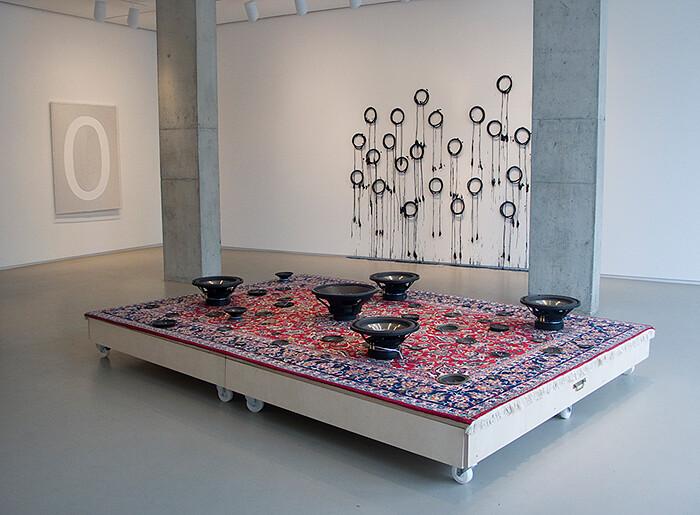Mounir Fatmi’s invocation of that evocative term “oriental” for his second US solo exhibition is no accident. The Paris-based Moroccan artist frequently draws on charged references—linguistic, political, and historical—to deepen the critical bite of his work. The artworks themselves, however, are usually juxtapositions of found objects that produce conceptual one-liners of a socio-political bent. The six recent works on view here are a remix of his material and thematic experiments of the past decade. At their best, they offer a first-hand encounter with the subtle sensory appeal of his playful appropriations and their skillful recasting of intellectual inquiry as visual pleasure. That said, their blunt symbolism and slick design suggest an opportunist aestheticization of the politics of the Arab Spring: by lining up a striking iconographic web of implied meanings (the artist’s North African origins included), the works hint at profound political critique without actually having to say very much.
The “oriental accident” of the show’s title is never quite explained, though it’s also the title of the 2011 work that greets the viewer upon entry. Loud, metallic vibrations call attention to the speakers mounted on the surface of a Persian carpet. The background noise coming from the speakers is that of a large demonstration, but the tinny ruckus is the result of metal nails sitting on the speakers’ surface, which jump and shake with the noise levels. Mounted on a portable platform (like a lo-fi approximation of a flying carpet), the work paints an image of recent uprisings in North Africa and the Middle East as a combination of tradition and technological modernity, whose actors are agitated by the waves of energy pulsing through them yet lack control over its actual machinations.
The stark symbolism of Oriental Accident continues in the work right behind it, a wall of what appear to be makeshift nooses dipped in black paint, revealed in the checklist to be iqals, the circles of rope that hold the Arab kefiyyeh in place. Lest we fail to grasp the tragi-sinister connotations of Arab headgear dripping with black ooze, the work has been titled Oil, Oil, Oil, Oil (2011). If there is an implied political connection in the juxtaposition of carpet and headgear, uprisings and oil men, it is not elucidated in the other works in the room, two relief paintings made of cable. Kissing Circles (2011) and The Year Zero (2012) are abstractions in the tradition of the early avant-garde, which use found material to connote obsolete forms of technological connectivity. They emphasize the circle motif that runs throughout the show, with its inevitable connotations of revolutions, cycles, circuits, and ciphers.
Fatmi’s skills as an audio-visual bricoleur come into their own with Modern Times: A History of the Machine (2009–10), the earliest work in the show and, in some ways, its most successful. Projected against the wall of the dark room is an animated diagram of a perplexing machine, its circular gears and cogs made up of calligraphic Arabic tondos, studded with planetary orbit charts, chemistry tables, and Duchampian rotoreliefs, like a pinball machine based on an Islamic astronomy manual. The machine spins to a sci-fi soundtrack of whirs, bleeps, and crackling static that highlights its combination of obsolescence and futurism. Here, the unresolved political iconography of the first gallery becomes a more discernible artistic statement: even if this “modern history” were diagrammatically laid out before us, not knowing the origin of its parts, the logic of its organization, or even its function, it will remain indecipherable.
Fair enough. Answers are overrated, or so Fatmi’s Modern Times seems to claim. The works ultimately gain meaning as metaphoric diagrams of history. Modern Times offers a potential comeback to critics like me seeking resolved (some may say didactic) political positions in their art: rather than political critique, the works are intended as psychic jolts that could potentially trigger moments of reflection and understanding in the viewer’s mind. Fair enough, but the work will need to lay the groundwork for that experience with more than a flying carpet and some stylish abstractions. The show proves that Fatmi is capable of politically ambitious and formally inventive work, though he may have to cut through the fortuitous oriental accidents to bring out its force and clarity.




